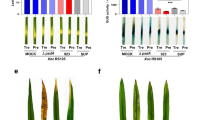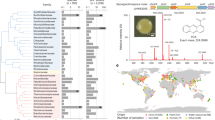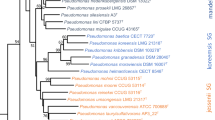Abstract
Natural disease-suppressive soils provide an untapped resource for the discovery of novel beneficial microorganisms and traits. For most suppressive soils, however, the consortia of microorganisms and mechanisms involved in pathogen control are unknown. To date, soil suppressiveness to Fusarium wilt disease has been ascribed to carbon and iron competition between pathogenic Fusarium oxysporum and resident non-pathogenic F. oxysporum and fluorescent pseudomonads. In this study, the role of bacterial antibiosis in Fusarium wilt suppressiveness was assessed by comparing the densities, diversity and activity of fluorescent Pseudomonas species producing 2,4-diacetylphloroglucinol (DAPG) (phlD+) or phenazine (phzC+) antibiotics. The frequencies of phlD+ populations were similar in the suppressive and conducive soils but their genotypic diversity differed significantly. However, phlD genotypes from the two soils were equally effective in suppressing Fusarium wilt, either alone or in combination with non-pathogenic F. oxysporum strain Fo47. A mutant deficient in DAPG production provided a similar level of control as its parental strain, suggesting that this antibiotic does not play a major role. In contrast, phzC+ pseudomonads were only detected in the suppressive soil. Representative phzC+ isolates of five distinct genotypes did not suppress Fusarium wilt on their own, but acted synergistically in combination with strain Fo47. This increased level of disease suppression was ascribed to phenazine production as the phenazine-deficient mutant was not effective. These results suggest, for the first time, that redox-active phenazines produced by fluorescent pseudomonads contribute to the natural soil suppressiveness to Fusarium wilt disease and may act in synergy with carbon competition by resident non-pathogenic F. oxysporum.
Similar content being viewed by others
Log in or create a free account to read this content
Gain free access to this article, as well as selected content from this journal and more on nature.com
or
References
Alabouvette C . (1986). Fusarium-wilt suppressive soils from the Châteaurenard region: review of a 10-year study. Agronomie 6: 273–284.
Alabouvette C . (1990). Biological control of Fusarium wilt pathogens in suppressive soils. In: Hornby D (ed). Biological Control of Soil-Borne Plant Pathogens. CAB International, Wallingford, England. pp 27–43.
Amir H, Amir A . (1989). Influence de la désinfection et du type de sol sur l'antagonisme d'un actinomycete vis-à-vis d'une souche de Fusarium oxysporum f sp. albedinis. Rev Ecol Biol Sol 26: 57–74.
Anjaiah V, Koedam N, Nowak-Thompson B, Loper JE, Höfte M, Tambong JT et al. (1998). Involvement of phenazines and anthranilate in the antagonism of Pseudomonas aeruginosa PNA1 and Tn5-derivatives towards Fusarium sp. and Pythium sp. Mol Plant-Microbe Interact 11: 847–854.
Bergsma-Vlami M, Prins ME, Staatzs M, Raaijmakers JM . (2005). Assessment of genotypic diversity of antibiotic producing Pseudomonas species in the rhizosphere by denaturing gradient gel electrophoresis. Appl Environ Microbiol 71: 993–1003.
Bull CT, Weller DM, Thomashow LS . (1991). Relationship between root colonization and suppression of Gaeumannomyces graminis var. tritici by Pseudomonas fluorescens strain 2-79. Phytopathology 81: 954–959.
Chin-A-Woeng TFC, Bloemberg GV, Van der Bij AJ, Van der Drift KMGM, Schripsema J, Kroon B et al. (1998). Biocontrol by phenazine-1-carboxamide producing Pseudomonas chlororaphis PCL1391 of tomato root rot caused by Fusarium oxysporum f. sp. radicis-lycopersici. Mol Plant-Microbe Interact 10: 79–86.
Chin-a-Woeng TFC, Bloemberg GV, Mulders IHM, Dekkers LC, Lugtenberg BJJ . (2000). Root colonization by phenazine-1-carboxamide-producing bacterium Pseudomonas chlororaphis PCL1391 is essential for biocontrol of tomato foot and root rot. Mol Plant-Microbe Interact 13: 1340–1345.
Cook RJ, Thomashow LS, Weller DM, Fujimoto D, Mazzola M, Bangera G et al. (1995). Molecular mechanisms of defense by rhizobacteria against root disease. Proc Natl Acad Sci USA 92: 4197–4201.
De La Fuente L, Mavrodi DV, Landa BB, Thomashow LS, Weller DM . (2006). phID-based genetic diversity and detection of genotypes of 2,4-diacetylphloroglucinol-producing Pseudomonas fluorescens. FEMS Microbiol Ecol 56: 64–78.
Dietrich LEP, Teal TK, Price-Whealan A, Newman DK . (2008). Redox-active antibiotics control gene expression and community behavior of divergent bacteria. Science 321: 1203–1206.
Duijff BJ, Recorbet G, Bakker PAHM, Loper J, Lemanceau P . (1999). Microbial antagonism at the root level is involved in the suppression of Fusarium wilt by the combination of non-pathogenic Fusarium oxysporum Fo47 and Pseudomonas putida WCS358. Phytopathology 89: 1073–1079.
Duffy BK, Défago G . (1999). Environmental factors modulating antibiotic and siderophore biosynthesis by Pseudomonas fluorescens biocontrol strains. Appl Environ Microbiol 65: 2429–2438.
Duffy BK, Keel C, Défago G . (2004). Potential role of pathogen signalling in multitrophic plant-microbe interactions involved in disease protection. Appl Environ Microbiol 70: 1836–1842.
Frapolli M, Défago G, Moënne-Loccoz Y . (2007). Multilocus sequence analysis of biocontrol fluorescent Pseudomonas spp. producing the antifungal compound 2,4-diacetylphloroglucinol. Environ Microbiol 9: 1939–1955.
Georgakopoulos D, Hendson M, Panopoulos NJ, Schroth MN . (1994). Cloning of a phenazine biosynthetic locus of Pseudomonas aureofaciens PGS12 and analysis of its expression in vitro with the ice nucleation reporter gene. Appl Environ Microbiol 60: 2931–2938.
Hernandez ME, Kappler A, Newman DK . (2004). Phenazines and other redox-active antibiotic promote microbial mineral reduction. Appl Environ Microbiol 70: 921–928.
Holloway BW . (1955). Genetic recombination in Pseudomonas aeruginosa. J Gen Microbiol 13: 572–581.
Hornby D . (1979). Take-all decline: a theorist's paradise. In: Schippers B, Gams W (eds). Soil-Borne Plant Pathogens. Academic Press: London. pp 133–156.
Howell CR, Stipanovic RD . (1979). Control of Rhizoctonia solani on cotton seedlings with Pseudomonas fluorescens and with an antibiotic produced by the bacterium. Phytopathology 69: 480–482.
Jaccard P . (1908). Nouvelles recherches sur la distribution florale. Bull Soc Vaud Sci Nat 44: 223–270.
Johnson KB . (1994). Dose–response relationships and inundative biological control. Phytopathology 84: 780–784.
Khan SR, Mavrodi DV, Jog GJ, Suga H, Thomashow LS, Farrand SK . (2005). Activation of the phz operon of Pseudomonas fluorescens 2-79 requires the LuxR homolog PhzR, N-(3-OH-hexanoyl)-L-homoserine lactone produced by the LuxI homologue PhzI, and a cis-acting phz-box. J Bacteriol 187: 6517–6527.
Kimura M . (1980). A simple method for estimating evolutionary rate of base substitution through comparative studies of nucleotide sequences. J Mol Evol 16: 111–120.
King EO, Ward MK, Raney DE . (1954). Two simple media for demonstration of pyocyanin and fluorescein. J Lab Clin Med 44: 301–307.
Kloepper JW, Leong J, Teintze M, Schroth MN . (1980). Pseudomonas siderophores: a mechanism explaining disease-suppressive soils. Curr Microbiol 4: 327–330.
Landa BB, Mavrodi OV, Raaijmakers JM, McSpadden-Gardener BB, Thomashow LS, Weller DM . (2002). Differential ability of genotypes of 2,4-diacetylphloroglucinol-producing Pseudomonas fluorescens to colonize the roots of pea. Appl Environ Microbiol 68: 3226–3237.
Landa BB, Mavrodi OV, Schroeder KL, Allende-Mola R, Weller DM . (2006). Enrichment and genotypic diversity of phlD-containing fluorescent Pseudomonas spp. in two soils after a century of wheat and flax monoculture. FEMS Microbiol Ecol 55: 351–368.
Larkin RP, Hopkins DL, Martin FN . (1996). Suppression of Fusarium wilt of watermelon by non-pathogenic Fusarium oxysporum and other microorganisms recovered from disease suppressive soil. Phytopathology 86: 812–819.
Latour X, Corberand T, Laguerre G, Allard F, Lemanceau P . (1996). The composition of fluorescent pseudomonad populations associated with roots is influenced by plant and soil type. Appl Environ Microbiol 62: 2449–2456.
Lemanceau P, Alabouvette C . (1991). Biological control of Fusarium diseases by fluorescent Pseudomonas and non-pathogenic Fusarium. Crop Protect 10: 279–286.
Lemanceau P, Alabouvette C . (1993). Suppression of Fusarium wilts by fluorescent pseudomonads: mechanisms and applications. Biocontrol Sci Technol 3: 219–234.
Lemanceau P, Alabouvette C, Couteaudier Y . (1988). Recherches sur la résistance des sols aux maladies. XIV. Modification du niveau de réceptivité d'un sol résistant et d'un sol sensible aux fusarioses vasculaires en réponse à des apports de fer ou de glucose. Agronomie 8: 155–162.
Lemanceau P, Bakker PAHM, De Kogel WJ, Alabouvette C, Schippers B . (1992). Effect of pseudobactin 358 production by Pseudomonas putida WCS358 on suppression of Fusarium wilt of carnations by non-pathogenic Fusarium oxysporum Fo47. Appl Environ Microbiol 58: 2978–2982.
Lemanceau P, Bakker PAHM, De Kogel WJ, Alabouvette C, Schippers B . (1993). Antagonistic effect of non-pathogenic Fusarium oxysporum Fo47 and pseudobactin 358 upon pathogenic Fusarium oxysporum f. sp. dianthi. Appl Environ Microbiol 59: 74–82.
Lemanceau P, Maurhofer M, Défago G . (2006). Contribution of studies on suppressive soils to the identification of bacterial biocontrol agents and to the knowledge of their modes of action. In: Gnanamanickam SS (ed). Plant-Associated Bacteria. Springer: Dordrecht. pp 231–267.
Mavrodi DV, Blankenfeldt W, Thomashow LS . (2006). Phenazine compounds in fluorescent Pseudomonas spp. biosynthesis and regulation. Annu Rev Phytopathol 44: 417–445.
Mavrodi OV, McSpadden-Gardener BB, Mavrodi DV, Bonsall RF, Weller DM, Thomashow LS . (2001). Genetic diversity of phlD from 2,4-diacetylphloroglucinol-producing fluorescent Pseudomonas species. Phytopathology 91: 35–43.
McSpadden-Gardener BB, Mavrodi DV, Thomashow LS, Weller DM . (2001). A rapid polymerase chain reaction-based assay characterizing rhizosphere populations of 2,4-diacetylphloroglucinol-producing bacteria. Phytopathology 91: 44–54.
McSpadden-Gardener BB, Schroeder KL, Kalloger SE, Raaijmakers JM, Thomashow LS, Weller DM . (2000). Genotypic and phenotypic diversity of phlD-containing Pseudomonas isolated from the rhizosphere of wheat. Appl Environ Microbiol 66: 1939–1946.
Notz R, Maurhofer M, Dubach H, Haas D, Defago G . (2002). Fusaric acid-producing strains of Fusarium oxysporum alter 2,4-diacetylphloroglucinol biosynthetic gene expression in Pseudomonas fluorescens CHA0 in vitro and in the rhizosphere of wheat. Appl Environm Microbiol 68: 2229–2235.
Olivain C, Alabouvette C, Steinberg C . (2004). Production of a mixed inoculums of Fusarium oxysporum Fo47 and Pseudomonas fluorescens C7 to control Fusarium diseases. Bio Sci Technol 14: 227–238.
Pierson LS, Thomashow LS . (1992). Cloning and heterologous expression of the phenazine biosynthetic locus from Pseudomonas aureofaciens 30-84. Mol Plant-Microbe Interact 5: 330–339.
Price-Whelan A, Dietrich LE, Newman DK . (2006). Rethinking ‘secondary’ metabolism: physiological roles for phenazine antibiotics. Nat Chem Biol 2: 71–78.
Raaijmakers JM, Leeman M, van Oorschot MMP, van der Sluis I, Schippers B, Bakker PAHM . (1995). Dose–response relationships in biological control of Fusarium wilt of radish by Pseudomonas spp. Phytopathology 85: 1075–1081.
Raaijmakers JM, Weller DM . (1998). Natural plant protection by 2,4-diacetylphloroglucinol-producing Pseudomonas spp. in take-all decline soils. Mol Plant-Microbe Interact 11: 144–152.
Raaijmakers JM, Weller DM . (2001). Exploiting genotypic diversity of 2,4-diacetylphloroglucinol producing Pseudomonas spp.: characterization of superior root-colonizing P. fluorescens strain Q8r1-96. Appl Environ Microbiol 67: 2545–2554.
Raaijmakers JM, Weller DM, Tomashow LS . (1997). Frequency of antibiotic-producing Pseudomonas sp. in natural environments. Appl Environ Microbiol 63: 881–887.
Rademaker JLW, Louws FJ, De Bruijn FJ . (1997). Characterization of the diversity of ecologically important microbes by rep-PCR genomic fingerprinting. In: Akkermans ADL, Van Elsas D, De Bruijn JD (eds). Supplement 3, chapter 3.4.3 Molecular Microbial Ecology Manual. Kluwer Academic Publishers: Dordrecht. pp 1–26.
Ramette A, Moënne-Loccoz Y, Défago G . (2003). Prevalence of fluorescent pseudomonads producing antifungal phloroglucinols and/or hydrogen cyanide in soils naturally suppressive or conducive to tobacco black rot. FEMS Microbiol Ecol 44: 35–43.
Ramette A, Moënne-Loccoz Y, Défago G . (2006). Genetic diversity and biocontrol potential of fluorescent pseudomonads producing phloroglucinols and HCN from Swiss soils naturally suppressive or conducive to Thielaviopsis basicola-mediated black root rot of tobacco. FEMS Microbiol Ecol 55: 369–381.
Rouxel F, Alabouvette C, Louvet J . (1979). Recherches sur la résistance des sols aux maladies. IV. Mise en évidence du rôle des Fusarium autochtones dans la résistance d'un sol à la Fusariose vasculaire du Melon. Ann Phytopathol 2: 199–207.
Saitou N, Nei M . (1987). The neighbor-joining method: a new method for reconstructing phylogenetic trees. Mol Biol Evol 4: 406–425.
Scher FM, Baker R . (1980). Mechanism of biological control in a Fusarium-suppressive soil. Phytopathology 70: 412–417.
Scher FM, Baker R . (1982). Effect of Pseudomonas putida and a synthetic iron chelator on induction of suppressiveness to Fusarium-wilt pathogens. Phytopathology 72: 1567–1573.
Schouten A, van den Berg G, Edel-Hermann V, Steinberg C, Gautheron N, Alabouvette C et al. (2004). Defense responses of Fusarium oxysporum to 2,4-diacetylphloroglucinol, a broad-spectrum antibiotic produced by Pseudomonas fluorescens. Mol Plant-Microbe Interact 17: 1201–1211.
Shanahan P, O'Sullivan DJ, Simpson P, Glennon JD, O'Gara F . (1992). Isolation of 2,4-diacetylphloroglucinol from a fluorescent pseudomonad and investigation of physiological parameters influencing its production. Appl Environ Microbiol 58: 353–358.
Simon A, Ridge EH . (1974). The use of ampicillin in a simplified selective medium for the isolation of fluorescent pseudomonads. J Appl Bacteriol 37: 459–460.
Sivan A, Chet I . (1989). The possible role of competition between Trichoderma harzianum and Fusarium oxysporum on rhizosphere colonization. Phytopathology 79: 198–203.
Souza JT, Weller DM, Raaijmakers JM . (2003a). Frequency, diversity, and activity of 2,4-diacetylphloroglucinol-producing fluorescent Pseudomonas spp. in Dutch take-all decline soils. Phytopathology 93: 54–63.
Souza JT, Arnould C, Deulvot C, Lemanceau P, Gianinazzi-Pearson V, Raaijmakers JM . (2003b). Effect of 2,4-diacetylphloroglucinol on Pythium species: cellular responses and variation in sensitivity among propagules and species. Phytopathology 93: 966–975.
Steinberg C, Edel-Hermann V, Guillemaut C, Pérez-Piqueres A, Singh P, Alabouvette C . (2004). Impact of organic amendments on soil suppressiveness to diseases. In: Sikora RA, Gowen S, Hauschild R, Kiewnick S (eds). Multitrophic Interactions in Soil and Integrated Control, 1–4 June 2003: IOBC wprs Bulletin/Bulletin OILB srop Bonn, Germany. pp 259–266.
Steinberg C, Edel-Hermann V, Alabouvette C, Lemanceau P . (2007). Soil suppressiveness to plant diseases. In: Van Elsas D, Jansson JK, Trevors JT (eds). Modern Soil Microbiology, 2nd edn. CRC Press, Taylor & Francis Group: London. pp 455–477.
Stutz EW, Défago G, Kern H . (1986). Naturally occurring fluorescent pseudomonads involved in suppression of black root rot of tobacco. Phytopathology 76: 181–185.
Thomashow LS, Weller DM . (1988). Role of a phenazine antibiotic from Pseudomonas fluorescens in biological control of Gaeumannomyces graminis var. tritici. J Bacteriol 170: 3499–3508.
Thompson JD, Higgins DG, Gibson TJ . (1994). CLUSTALW: improving the sensitivity of progressive multiple sequence alignment through sequence weighting, positions-specific gap penalties and weight matrix choice. Nucleic Acids Res 22: 4673–4680.
Van Rij ET, Wesselink M, Chin-A-Woeng TFC, Bloemberg GV, Lugtenberg BJJ . (2004). Influence of environmental conditions on the production of phenazine-1-carboxamide by Pseudomonas chlororaphis PCL1391. Mol Plant-Microbe Interact 17: 557–566.
Van Rij ET, Girard G, Lugtenberg BJJ, Bloemberg GV . (2005). Influence of fusaric acid on phenazine-1-carboxamide synthesis and gene expression of Pseudomonas chlororaphis strain PCL1391. Microbiology 151: 2805–2814.
Vincent MN, Harrison LA, Brackin JM, Kovacevich PA, Mukerji P, Weller DM et al. (1991). Genetic analysis of the antifungal activity of a soilborne Pseudomonas aureofaciens strain. Appl Environ Microbiol 57: 2928–2934.
Wang Y, Newman DK . (2008). Redox reactions of phenazine antibiotics with ferric (hydr)oxides and molecular oxygen. Environ Sci Technol 42: 2380–2386.
Wang C, Ramette A, Punjasamarnwong P, Zala M, Natsch A, Moenne-Loccoz Y et al. (2001). Cosmopolitan distribution of phlD-containing dicotyledonous crop-associated biocontrol pseudomonads of worldwide origin. FEMS Microbiol Ecol 37: 105–116.
Weller DM, Cook RJ . (1983). Suppression of take-all of wheat by seed treatment with fluorescent pseudomonads. Phytopathology 73: 463–469.
Weller DM, Raaijmakers JM, McSpadden Gardener BB, Thomashow LS . (2002). Microbial populations responsible for specific soil suppressiveness to plant pathogens. Annu Rev Phytopathol 40: 309–348.
Yuen GY, Schroth MN . (1986). Interactions of Pseudomonas fluorescens strain E6 with ornamental plants and its effect on the composition of root-colonizing microflora. Phytopathology 76: 176–180.
Acknowledgements
This study was funded by OECD, the Regional Council of Burgundy (Dijon, France), the Royal Dutch Academy of Arts and Sciences (KNAW) and NWO-Van Gogh (project VGP 83-192). We are grateful to DV Mavrodi and LS Thomahsow (USDA-ARS, Washington State University, Pullman, WA, USA) for kindly providing the phenazine-deficient mutant 2-79Z. We also acknowledge the Experimental Unit of INRA (SEDE, Dijon, France) for biocontrol assay facilities.
Author information
Authors and Affiliations
Corresponding author
Additional information
Supplementary Information accompanies the paper on The ISME Journal website (http://www.nature.com/ismej)
Rights and permissions
About this article
Cite this article
Mazurier, S., Corberand, T., Lemanceau, P. et al. Phenazine antibiotics produced by fluorescent pseudomonads contribute to natural soil suppressiveness to Fusarium wilt. ISME J 3, 977–991 (2009). https://doi.org/10.1038/ismej.2009.33
Received:
Revised:
Accepted:
Published:
Issue date:
DOI: https://doi.org/10.1038/ismej.2009.33
Keywords
This article is cited by
-
Pseudomonas is a key player in conferring disease suppressiveness in organic farming
Plant and Soil (2023)
-
Trophic interactions between predatory protists and pathogen-suppressive bacteria impact plant health
The ISME Journal (2022)
-
Exploring rhizo-microbiome transplants as a tool for protective plant-microbiome manipulation
ISME Communications (2022)



